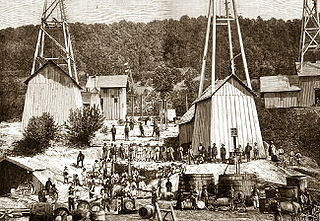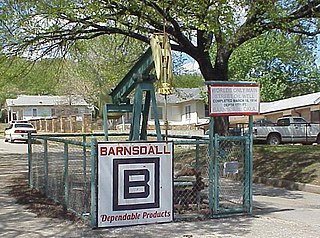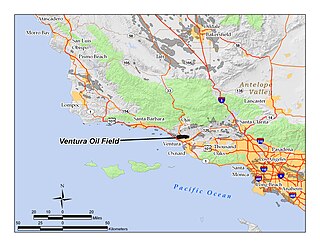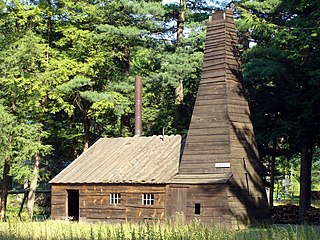
The history of the petroleum industry in the United States goes back to the early 19th century, although the indigenous peoples, like many ancient societies, have used petroleum seeps since prehistoric times; where found, these seeps signaled the growth of the industry from the earliest discoveries to the more recent.

Spindletop is an oil field located in the southern portion of Beaumont, Texas, in the United States. The Spindletop dome was derived from the Louann Salt evaporite layer of the Jurassic geologic period. On January 10, 1901, a well at Spindletop struck oil. The Spindletop gusher blew for 9 days at a rate estimated at 100,000 barrels (16,000 m3) of oil per day. Gulf Oil and Texaco, now part of Chevron Corporation, were formed to develop production at Spindletop. The Spindletop discovery led the United States into the oil age. Prior to Spindletop, oil was primarily used for lighting and as a lubricant. Because of the quantity of oil discovered, burning petroleum as a fuel for mass consumption suddenly became economically feasible.

The Petroleum Trail is an international tourist trail which runs from Poland to Ukraine linking places associated with the petroleum industry of the 19th century.
Robert M. McFarlin was an American oilman, cattle rancher, philanthropist, and businessman who is best known for amassing a fortune by drilling for oil near Glenpool, Oklahoma with his nephew and son-in-law, James A. Chapman. He was among the early pioneer oilmen who established the state of Oklahoma as a center of the oil industry in the early part of the 20th century.

Burning Springs is an unincorporated community in Wirt County, West Virginia, United States. It takes its name from the natural gas which bubbled up through the spring and would burn when lit.

The petroleum industry in Azerbaijan produces about 873,260 barrels (138,837 m3) of oil per day and 29 billion cubic meters of gas per year as of 2013. Azerbaijan is one of the birthplaces of the oil industry. Its history is linked to the fortunes of petroleum. It is poised to become an important oil and gas producer once again.

The Canadian petroleum industry arose in parallel with that of the United States. Because of Canada's unique geography, geology, resources and patterns of settlement, however, it developed in different ways. The evolution of the petroleum sector has been a key factor in the history of Canada, and helps illustrate how the country became quite distinct from her neighbour to the south.

The Barnsdall Main Street Well is a formerly active oil well in the middle of Main Street in the town of Barnsdall, Oklahoma. It is believed to be the only such oil well anywhere in the world. It was listed on the National Register of Historic Places (NRHP) on October 1, 1997, as part of the "Energy Related Resources in Northeastern Oklahoma Multiple Property Submission". According to signage at the site, the well was completed on March 18, 1914, with a depth of 1771 feet. It remained active until the 1960s.

Well No. 4, Pico Canyon Oilfield, located about seven miles (11 km) west of Newhall, California, in the Santa Susana Mountains, was the first commercially successful oil well in the Western United States and is considered the birthplace of California's oil industry. Drilled in 1876, it turned nearby Newhall into a boomtown and also spawned a smaller boomtown called Mentryville adjacent to the drilling site. Well No. 4 continued in operation for 114 years until it was capped in 1990. The site was designated a National Historic Landmark in 1966, and the Mentryville ghost town is now open to the public as a historic park.

The Ventura Oil Field is a large and currently productive oil field in the hills immediately north of the city of Ventura in southern California in the United States. It is bisected by California State Route 33, the freeway connecting Ventura to Ojai, and is about eight miles (13 km) long by two across, with the long axis aligned east to west. Discovered in 1919, and with a cumulative production of just under a billion barrels of oil as of 2008, it is the tenth-largest producing oil field in California, retaining approximately 50 million barrels in reserve, and had 423 wells still producing. As of 2009 it was entirely operated by Aera Energy LLC.
Offshore oil and gas in the Gulf of Mexico is a major source of oil and natural gas in the United States. The western and central Gulf of Mexico, which includes offshore Texas, Louisiana, Mississippi, and Alabama, is one of the major petroleum-producing areas of the United States. Oil production from US federal waters in the Gulf of Mexico reached an all-time annual high of 1.65 million barrels per day in 2017. Oil production is expected to continue the upward trend in 2018 and 2019, based on ten new oil fields which are planned to start production in those years. According to the Energy Information Administration, "Gulf of Mexico federal offshore oil production accounts for 17% of total U.S. crude oil production and federal offshore natural gas production in the Gulf accounts for 5% of total U.S. dry production."

The Oklahoma City Oil Field is one of the world's giant petroleum fields and is located in Oklahoma City, Oklahoma in the United States of America. The field was opened just south of the city limits on December 4, 1928, and first entered Oklahoma City limits on May 27, 1930.

The First Oil Well in Western Canada also known as Lineham Discovery Well No. 1, is a defunct oil well and National Historic Site of Canada which commemorates the 21 September 1902 oil strike in what is now Waterton Lakes National Park, Alberta. The oil well originally drilled in 1902, was the first productive oil well in the Western Canadian Provinces.

The Drake Well is a 69.5-foot-deep (21.2 m) oil well in Cherrytree Township, Venango County in the U.S. state of Pennsylvania, the success of which sparked the first oil boom in the United States. The well is the centerpiece of the Drake Well Museum located 3 miles (5 km) south of Titusville.

The First Oil Well in Oklahoma was drilled in 1885 in Atoka County, Choctaw Nation, Indian Territory, though it was not completed until 1888.

The Wheeler No. 1 Oil Well was the first well drilled in the Drumright-Cushing Oil Field of northeast Oklahoma, near Drumright. The success of the well, drilled in 1912 by Thomas Baker Slick, Sr., led to the development of the Cushing field and gave impetus to the early development of Oklahoma oilfields. The Drumright-Cushing field would go on to produce 310,000 barrels of oil a day at its peak in May 1917. The well made Slick's name as "King of the Wildcatters".

The Cushing Oil Field, also known as the Cushing-Drumright Oil Field, is an oil field in northeastern Oklahoma, part of the Mid-Continent oil province. The 10-mile (16 km) by 3-mile (4.8 km) field includes southeastern Payne County, northwestern Creek County, and northeastern Lincoln County. Named for its primary supply center at Cushing, Oklahoma, the field was developed from 1912.

Nellie Johnstone No. 1 was the first commercially productive oil well in Oklahoma. Completed on April 15, 1897, the well was drilled in the Bartlesville Sand near Bartlesville, opening an era of oil exploration and development in Oklahoma. It was abandoned as a well in 1964. The site was donated to the city of Bartlesville and is now a park, listed on the National Register of Historic Places, featuring a restored drilling rig.

Cat Creek is an unincorporated community in eastern Petroleum County, Montana, United States.

The discovery of the Glenn Pool Oil Reserve in 1905 brought the first major oil pipelines into Oklahoma, and instigated the first large scale oil boom in the state. Located near what was—at the time—the small town of Tulsa, Oklahoma, the resultant establishment of the oil fields in the area contributed greatly to the early growth and success of the city, as Tulsa became the petroleum and transportation center of the state, and the world. Several Creek Indian land allotment owners became millionaires; Oklahoma became the world's largest oil producer for years; and the area benefited from the generation of more wealth than the California Gold Rush and Nevada Silver Rush combined, as well as the increased investment capital and industrial infrastructure the boom brought with it. The town of Glenpool, Oklahoma was founded in 1906 as a direct result of the oil reserve's discovery.



















